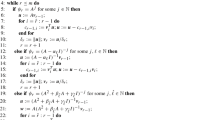Abstract
We propose a two algorithms for computation of (sharp) enclosures of definite interevals: alocal adaptive algorithm (LAA) and aglobal adaptive algorithm (GAA). Both algorithms are based on Gauss-Legendre quadrature. Error terms are bounded using automatic differentiation in combination with interval evaluations.
Several numerical examples are presented; these examples include comparison with an adaptive interval Romberg scheme.
Abstract
Предлагаются два алгоритма для вычисления (тесных) включений определенных интегралов: локальный адаптивный алгоритм и глобальный адаптивный алгоритм. Оба алгоритма основаны на квадратуре Гаусса-Лежандра. Члены, характеризующие погрещность, находятся с помощью автоматического дифференцирования в сочетании с интервальными оценками.
Представлено несколько численных примеров, которые включают сравнение с адаптивной интервальной схемой Ромберга.
Similar content being viewed by others
References
Adams, E. and Kulisch, U. (eds)Scientific computing with automatic result verification. Academic Press, San Diego, 1993.
Brass, H.Quadraturverfahren. Vandenhoeck & Ruprecht in Göttingen, 1977.
Gautschi, W..On the construction of Gaussian quadrature rules from modified moments. Math. Comp.24 (1970), pp. 245–260.
Kelch, R.Numerical quadrature by extrapolation with automatic result verification. In: [1], pp. 143–185.
Klatte, R., Kulisch, U., Neaga, M., Ratz, D., and Ullrich, Ch.PASCAL-XSC—language reference with examples. Springer-Verlag, 1992.
Krämer, W.Multiple-precision computations with result verification. In: [1], pp. 325–356.
Krämer, W. and Wedner, S.Computing narrow inclusions for Cauchy principal value integrals. In: Alefeld, G. and Frommer, A. (eds) “Scientific Computing and Validated Numerics”, Akademie Verlag, Berlin, 1996, pp. 45–51.
Kulisch, U. W. and Miranker, W. L. (eds)Computer arithmetic in theory in practice. Academic Press, New York, 1981.
Lohner, R.Habilitationsschrift. Universität Karlsruhe, 1994.
Niederdrenk, K. and Yserentant, H.Funktionen einer reellen Veränderlichen. Rechnerorientierte Ingenieurmathematik, Vieweg, 1987.
Rall, L. B.Differentiation and generating of Taylor coefficients in PASCAL-SC. In: [8].
Sack, R. A. and Donovan, A. F.An algorithm for Gaussian quadrature given modified moments. Numer. Math.18 (1972), pp. 465–478.
Stoer, J. and Bulirsch, R.Introduction to numerical analysis. Springer-Verlag, 1980.
Storck, U.Verified calculation of the nodes and weights for Gaussian quadrature formulas. Interval Computation 4 (1993), pp. 114–124.
Wedner, S.Numerische Quadratur mit automatischer Ergebnisverifikation. Diplomarbeit, Universität Karlsruhe, 1994.
Weissinger, J.Numerische Mathematik auf Personal-Computern Teil 1. B.I.-Wissenschaftsverlag, 1984.
Author information
Authors and Affiliations
Additional information
© W. Krämer, S. Wedner, 1996
Rights and permissions
About this article
Cite this article
Krämer, W., Wedner, S. Two adaptive Gauss-Legendre type algorithms for the verified computation of definite integrals. Reliable Comput 2, 241–253 (1996). https://doi.org/10.1007/BF02391698
Received:
Revised:
Issue Date:
DOI: https://doi.org/10.1007/BF02391698




